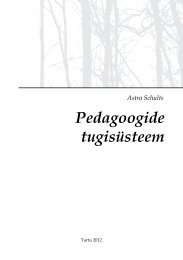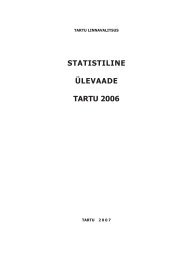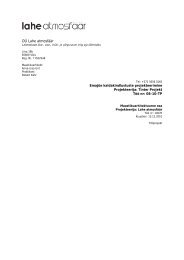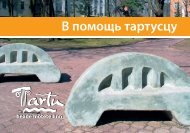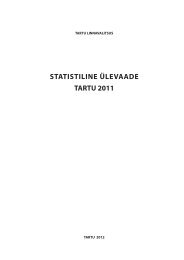Festivals - Tartu
Festivals - Tartu
Festivals - Tartu
Create successful ePaper yourself
Turn your PDF publications into a flip-book with our unique Google optimized e-Paper software.
discover such unexpected locations and transform them for a performative use is their<br />
core business and chief mandate. The notion that a performance should take place on<br />
a fixed stage, in buildings specifically constructed for performances, in theatre venues,<br />
is in fact a rather limiting condition of performance and historically one that has<br />
marked the performative practice only since the end of the 16th century when the first<br />
durable theatre buildings were built in Madrid and at the periphery of London. Even<br />
in those 400 years since then, performative practices were never limited to those venues<br />
alone. The search for appealing alternatives to the standard theatre venue marks<br />
the experiments of several great artists of the 20th century, starting from the Salzburg<br />
Festival, established in 1920 by five artists including the composer Richard Strauss,<br />
the dramatist Hugo von Hoffmansthal, the director Max Reinhardt, the stage designer<br />
Alfred Roller and the conductor Franz Schalk. They staged the first performances on<br />
the steps of the Cathedral Square and then two years later in the baroque Felsenreitschule<br />
(the Summer Riding School) in the historic centre of Salzburg. A few years later<br />
the large Festspielehaus was built and other theatres and concert halls came into use,<br />
but still today this most prestigious festival feels the need to present some performances<br />
in unconventional spaces such as a former salt factory and to stage Jedermann<br />
at the open air in the Cathedral Square.<br />
Staging dramas or concerts in public squares in front of the cathedral or the main<br />
local church is in some countries a way to link the festival to traditions, such as in<br />
Italy, where the so called sacre rappresentazioni date back to the medieval times. Since<br />
the World War 2 several major theatre festivals established their distinction exactly<br />
in appropriating some historic or ex-industrial buildings for the performance, starting<br />
with Jean Vilar’s staging of the early Avignon Festival productions in the Cour<br />
d’Honeur of the Pope’s palace in Avignon, adding throughout the years many similar<br />
historic locations as stages. Since 1950, Dubrovnik Summer Festival systematically<br />
appropriated various fortresses, chapels, squares, palaces, beaches, ramparts for its<br />
productions and gradually brought their number to over forty. Many other festivals<br />
did the same, reviving their architectural heritage and making it work as an interface<br />
of artistic innovation and tourism development. It is the case of many theatre festivals<br />
staged in ancient Greek amphiteatres in various Mediterranean countries (eg. France,<br />
Greece, Italy, Spain, Turkey) as well of many music and theatre festivals taking place in<br />
castles and palaces. Sometimes the set is provided by a public space - such as a square,<br />
surrounded by old buildings, and for weeks every night it turns into an arena for the<br />
festival productions.<br />
36<br />
Inventing a space of performance, appropriating it and adapting it for a single use is a<br />
way for a festival to prove its own function in the creation of added value, additional<br />
cultural capital. This effort allows the festival to experiment in the spatial shapes and<br />
relationships of the performing and observing zones, in the communication patterns<br />
between the performers and the viewers. Bringing the public to an unknown, previously<br />
unfrequented space stresses the festive character of the festival and the forma-



